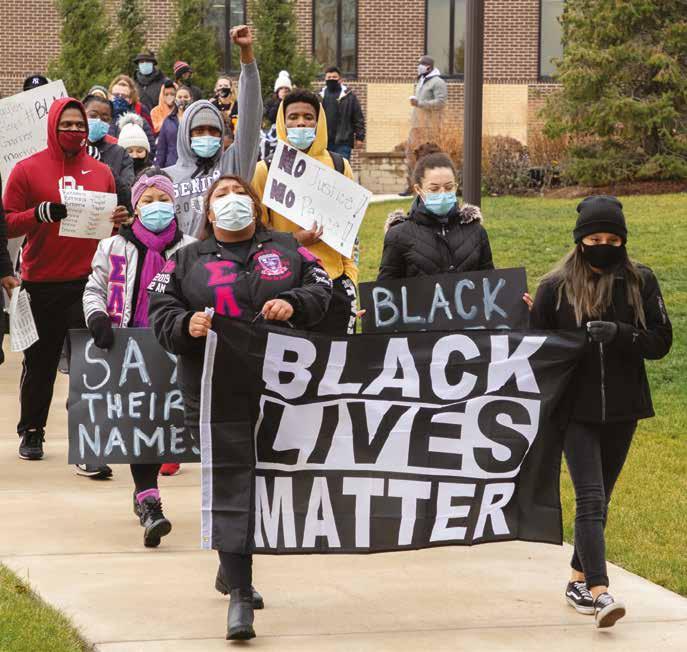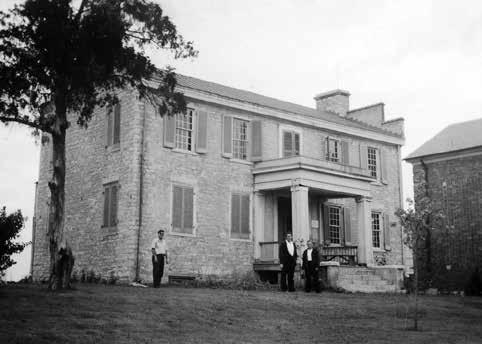
5 minute read
CharismaticEnergy:AnIntroductiontoRELAN
CHARISMATIC ENERGY: AN INTRODUCTION TO RELAN
Coming to North America
TheBrothersopened Ste.GenevièveAcademyin alimestoneFederalist-style buildinglocatedonthe highesthilloverlooking thetownofSte.Geneviève. The Lasallian mission in the Lasallian Region of North America (RELAN) traces its historical roots to 1819 and Ste. Geneviève Academy in Ste. Geneviève, Missouri, the first school operated by the De La Salle Christian Brothers in the United States. The school operated only until 1822; it wasn’t until 1837, when Brother Aidant and three Brothers debarked in Montréal, that they established the first permanent foundation of the Institute of the Brothers of the Christian Schools in North America. Alighting from those ships were men imbued with a charism and vision that would transform the educational landscape in its day.
Inspired by De La Salle
The Lasallian charism traces its roots to Saint John Baptist de La Salle and the first communities of Brothers. The grace and gift of the Holy Spirit filled them with an energy to associate together for the educational service of the poor. This charismatic energy expressed itself in three integrated and dynamic ways: in gratuity, founding and justice.
Nearly two hundred years later, this charismatic energy continues to find expression in the countries of Canada and the United States. Today, as in our origins, this energy brings the living love of Christ into the teacher-student relationship and transforms the educational center into a redemptive and saving place.
Charismatic Dynamism in Action
This Bulletin offers a tour of the Lasallian Region of North America and the many expressions of the charismatic dynamism that
narrate its past and present. RELAN is comprised of four Districts: Eastern North America, Francophone Canada, Midwest and San Francisco New Orleans. There are nearly 500 Brothers and 10,000 Partners serving in association to touch the hearts and minds of nearly 77,000 youth and young adults in more than 80 elementary, middle and secondary (high) schools, colleges and universities, educational centers, youth and family services centers, retreat and pastoral centers, and camps.
The educational system in the United States and Canada is elementary (5-10 years), middle school (10-13 years), high school (13-18 years), and college and universities for adults. More than half of the educational ministries are high schools. Four of those are low-tuition Cristo Rey-model schools where economically disadvantaged students complement academic studies with professional work experience. Eleven are San Miguel-model middle schools, largely located in low-income neighborhoods that provide quality education to underserved students. Additionally, youth and family services, retreat and pastoral centers, after-school programs and camps bring the Lasallian mission to life for youth and young adults.
In Canada, the educational system varies from province (state) to province. In Québec, until a few years ago, public schools were either Catholic or Protestant, and they were all fully subsidized by the state. For about 30 years, the system has been secular, but a private system exists, which can be Catholic, and it is subsidized by the state up to about 60%; all this ensured that, for many years, Lasallian schools could easily carry out their mission among the poor and the working classes. At this time, there is one Lasallian school in Canada. As this school chose some years ago to regain its autonomy and become wholly private, it receives no state funding.
In the United States, Catholic schools are not funded by the state or federal government—there is a strict interpretation of the separation between church and state. Salaries and operating
BrotherRobertvisited CathedralHighSchool inElPaso,Texas,just daysbeforecancelingthe remainderofhispastoral visittoRELANbecause ofCOVID-19concerns.
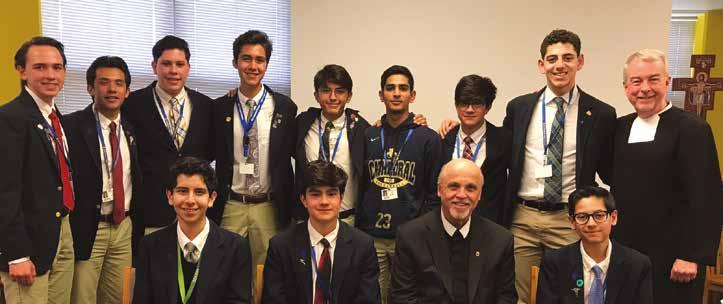
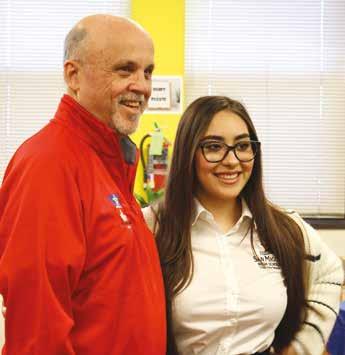
and capital expenses for the site and buildings are provided by tuition and fees from the families. In this tuition and benefactor-dependent model, the vitality and sustainability are dependent upon the educational community. Keeping the doors open in a literal sense and keeping the doors open to faith in a pastoral sense is quite dependent upon the revenue that is generated from the families and from fundraising.
SanMiguelHighSchoolin Tucson,Arizona,serves familiesoflimitedfinancial means.AsaCristoRey-model school,itsCorporateWork StudyProgramplaces studentsinlocalbusinesses onedayaweektoprovide workexperienceand helpsupportthecostof theirtuition.
Together and by Association
To strengthen the Lasallian educational network, the Lasallian Association for Secondary School Chief Administrators (LASSCA) meets on an annual basis for formation and collaboration, and the Lasallian Association of Colleges and Universities (LACU) and its mission officers meet regularly to collaborate and sponsor events to promote dialogue and research. This LACU collaboration extends beyond the six institutions of higher education in the United States and includes Bethlehem University in the Holy Land, Christ the Teacher Institute of Education in Nairobi, Kenya, and Ethiopian Catholic University – La Salle in Addis Ababa, Ethiopia.
Two companies provide critical support for the people and programs of the Lasallian charism. Christian Brothers Services (CBS) administers cooperative programs in health, retirement, property/casualty, technology, school management, financial and administrative consulting to schools and church organizations. Christian Brothers Investment Services (CBIS) provides investment services for Catholic institutions worldwide. CBIS actively promotes and guides investors through its Catholic Responsible Investments program. Both companies provide services within and outside the Institute and Lasallian mission.
Gratuity, Founding and Justice
There are many contemporary examples in RELAN of the threefold charismatic energy of gratuity, founding and justice. In this Bulletin you will read about the founding of Lasallian Volunteers (1989), De La Salle Blackfeet (2001) and the Saint-Michel Lasallian Center (2005), examples that illustrate the indissoluble
link between these three aspects. The spirit of gratuity infuses the founding spirit, and the desire for justice inspires risk on behalf of those who are pushed to the social margins.
The charism moves to where the needs are. Sometimes it is located in brick and mortar, such as the First Generation Initiative at Saint Mary’s University of Minnesota that serves students who are the first in their families to pursue higher education. At times it’s found on the U.S.-Mexico border in the service-learning program El Otro Lado. And at times it is in those neighborhoods where Tides Family Services reaches out to disenfranchised youth.
BrotherRobertvisited theSaint-MichelLasallian Center,whichservesan immigrantpopulation inMontréal,Québec.
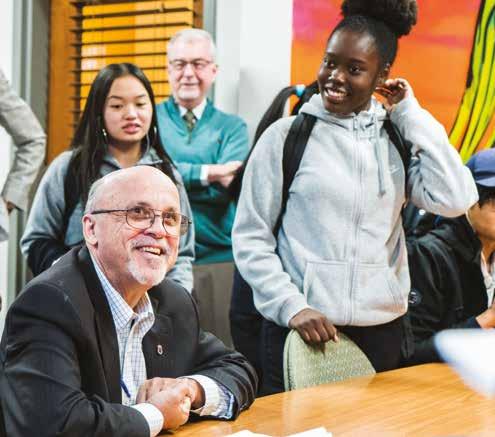
Responding to Challenges
The charism moves to respond to emerging social, religious and economic challenges, such as the systemic racism that has embedded itself in the United States, the growing number of youth who are stepping away from faith communities, and the growing gap between what families can pay and what schools charge for tuition. The resilience of this charism was especially tested during the COVID-19 crisis.
The Region’s aspiration is that the mission stands as a prophetic sign of justice and the community is a prophetic sign of love. In support of this aspiration, the Districts and Region dedicate their resources to restore justice and support the young.
In the following sections we would like to share with you how the people of RELAN work together to nourish and sustain the same charism and vision that was first brought to us 200 years ago. u
Withrenewedattention onracialjustice,Lasallian institutionsaretakingsteps toinitiatediscussions, examinetheirpoliciesand createchange.(Pictured: LewisUniversitystudent demonstration)
